Maximize Spotify’s equalizer to make your favorite music even more enjoyable with this guide.
Spotify offers a built-in equalizer (EQ) to tailor your listening experience, similar to top streaming platforms like Apple Music and Tidal.
However, the equalizer isn’t a one-size-fits-all solution, and its effect can yield varied results based on your audio gear and personal preference.
Luckily, understanding what Spotify’s equalizer presets do and learning about other audio improvement tips can help you optimize sound quality. We’ll discuss all this and more, so keep reading until the end!
How to Access the Spotify Equalizer
Accessing Spotify’s equalizer varies depending on your device. Here’s how to find it on iOS, Android, and desktop apps:
On iOS
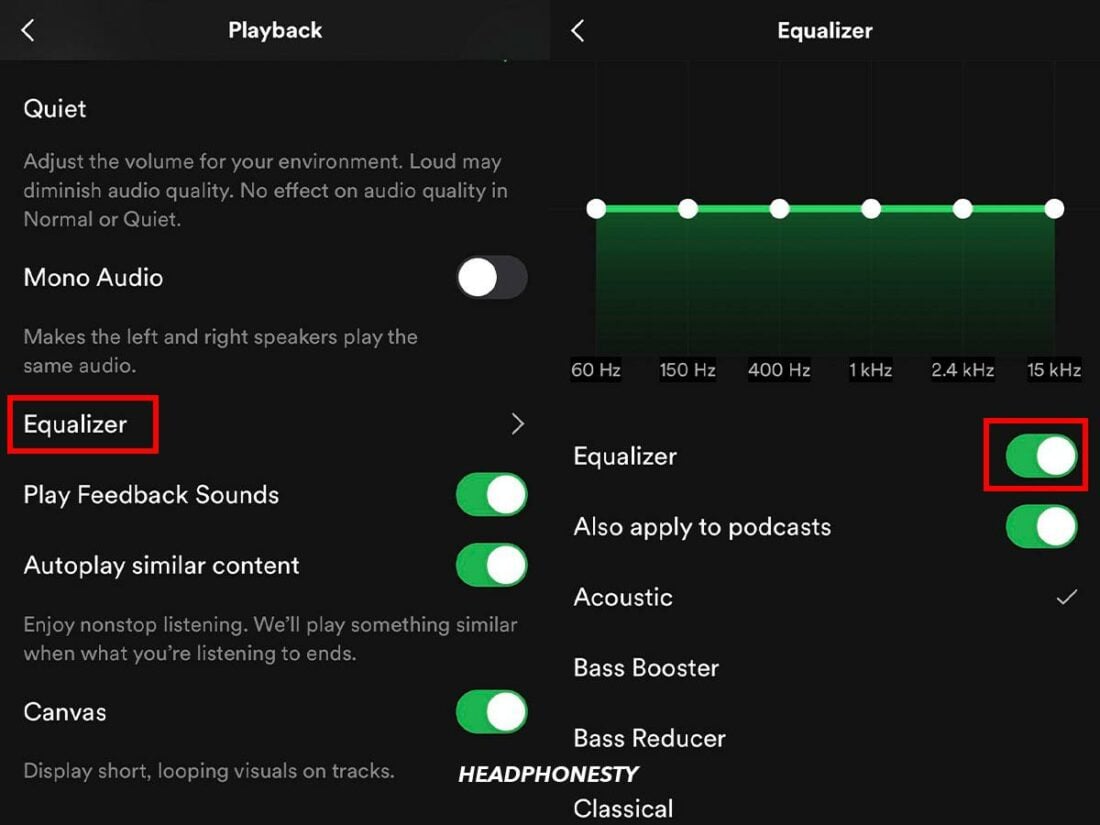
- Open Spotify and select Settings > Playback > Equalizer.
- Tap the toggle to enable Equalizer and choose from the available presets or adjust the frequencies manually using iOS’ six-band EQ that ranges from 16 Hz to 15 kHz.
On Android
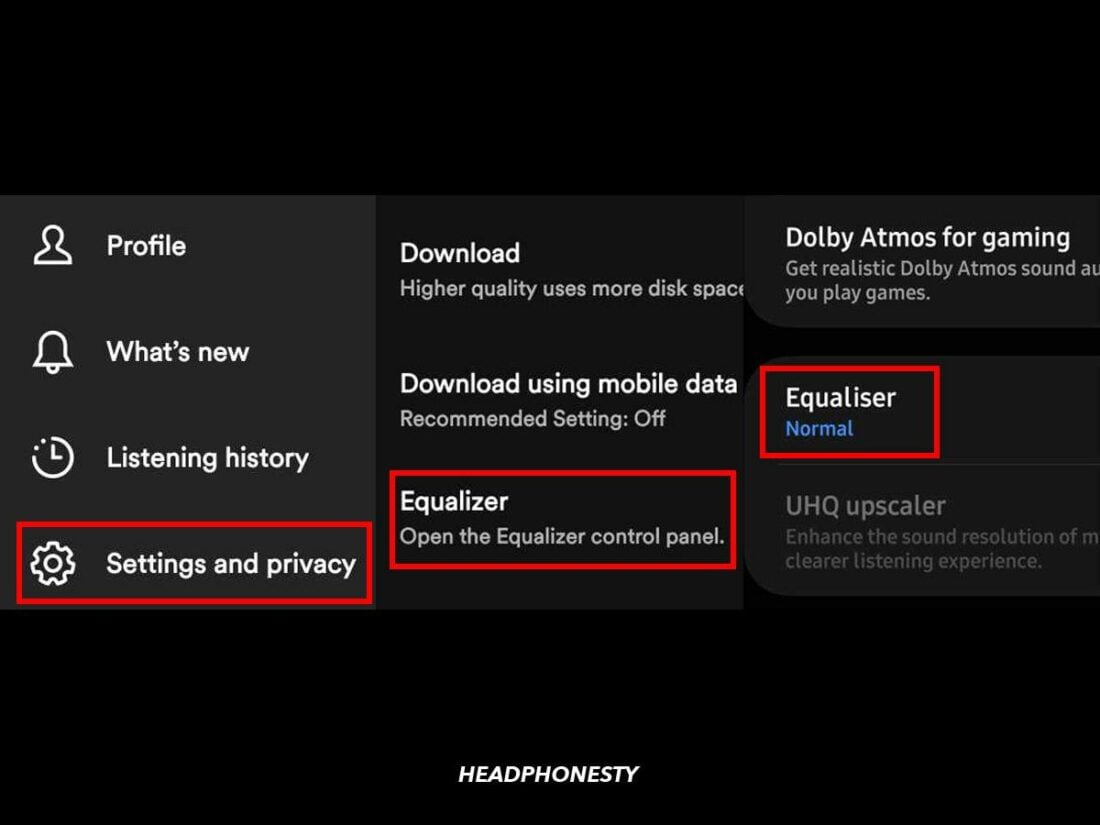
- Open Spotify, click on the profile icon and select Settings and privacy.
- Scroll down to Audio Quality, then tap Equalizer.
- Select Equaliser again under Sound quality and effects to view the presets or adjust the equalizer manually using the nine sliders that ranges from 63 Hz to 16 kHz.
On PC and Mac
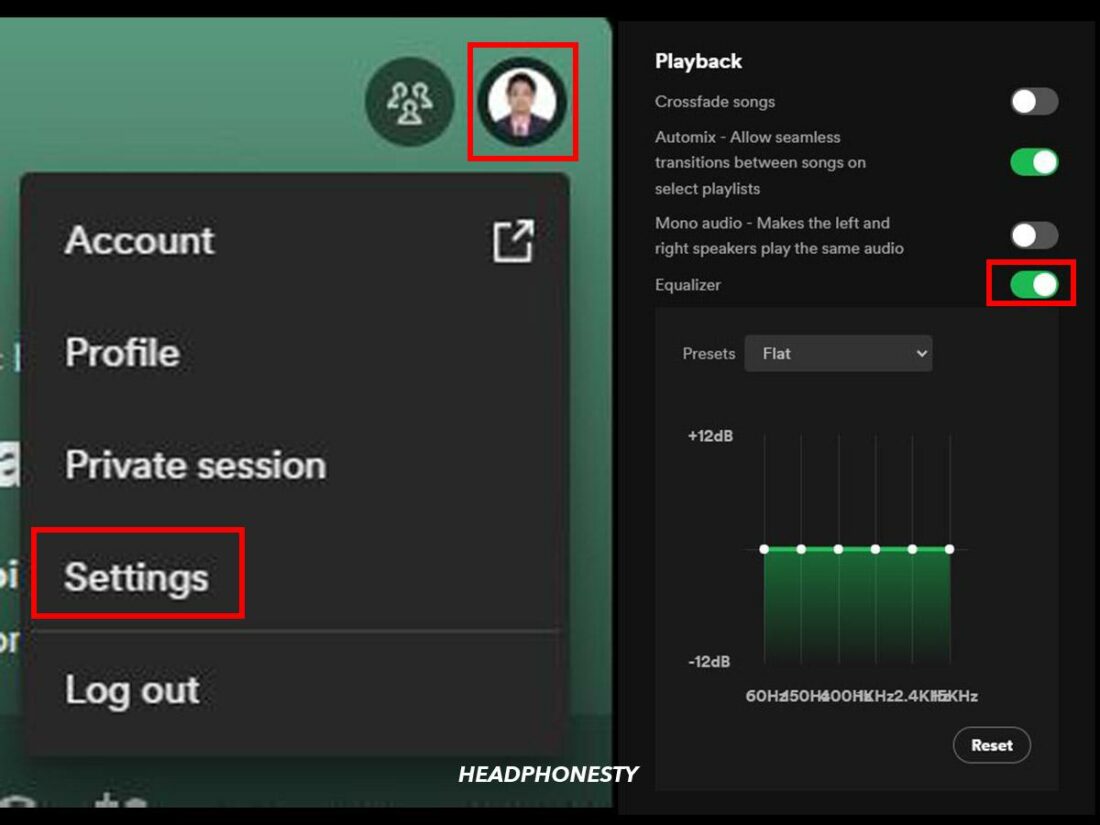
- Open Spotify and click your profile icon in the upper right corner.
- Click Settings and scroll down to Playback.
- Toggle Equalizer on to enable the feature and select a preset or adjust the sliders.
How to Choose the Best Spotify Equalizer Settings
Though equalizer settings are largely personal, some are considered ideal for specific audio types or music genres. Here are a few examples:
| Genre | Sound | Frequency Adjustments | Recommended Presets |
|---|---|---|---|
| HipHop/Club | Characterized by deeper and punchier bass. | Increase the bass (60-200 Hz). | Bass Booster and R&B |
| Jazz | Sounds warm and detailed due to the multiple instrumental layers. | Increase the bass (60-250 Hz) and treble (2.5-16 kHz). Reduce the low mids (500 Hz) to highlight high and low-end details. | Jazz, Loudness, R&B |
| Rock/Heavy Metal | These genres sound energetic across the board and heavy on double-bass drums and guitar distortion. | Increase the bass (60-200 Hz) and treble (2-16 kHz). Reduce the mids (250 Hz-1 kHz) to emphasize power without losing clarity. | Rock, Classical For headphones with a bassy sound signature, go for Flat or Normal. |
| EDM | Composed of electronic beats, synths, soaring melodies, and vocals. | Increase the bass (60-400 Hz) and upper mids (1-4 kHz). | Dance, Electronic, Acoustic, and Rock |
| Podcasts | A voice-centric audio genre with a natural, warm sound ideal for vocals. | Increase the bass and mids (100 Hz-1 kHz). | Pop, Deep, Spoken Word, and Vocal Booster |
Spotify Equalizer Presets on Android and iOS
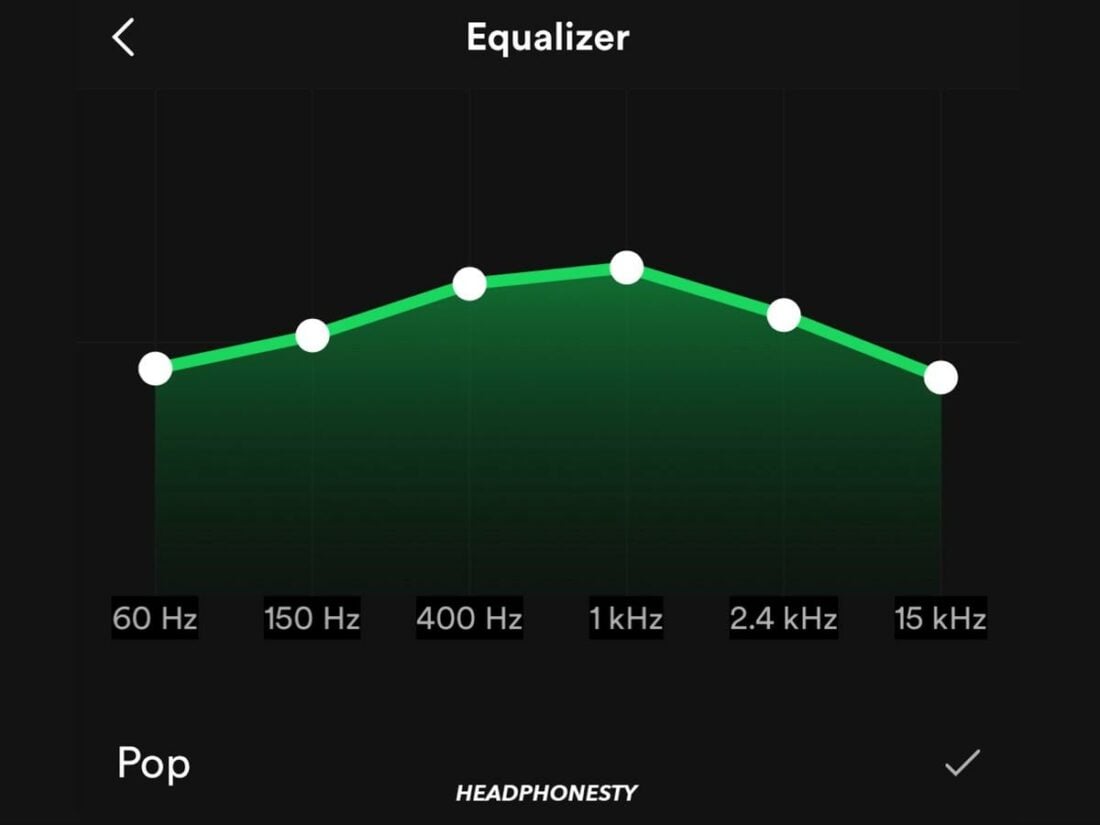
Spotify has five shared presets on the Android and iOS apps. Here’s what each sounds like:
| Preset | iOS | Android |
|---|---|---|
| Flat (iOS)/Normal (Android) | No frequencies are enhanced or reduced with this preset. | Same with iOS. |
| Pop | This preset boosts mids, reduces lows and highs, and highlights vocals. | It also boosts mids but has a flatter bass and more reduced highs than the iOS preset. |
| Classical | Somewhat V-shaped, with slightly increased highs and lows, but recessed mids. | Slightly more emphasis on low mids and highs. |
| Jazz | This profile boosts bass and treble while softening vocals by lowering the mids. | Significantly increases the lower mids and reduces the upper mids compared to the iOS preset. |
| Rock | Essentially the same as the Classical preset. | The reduction of the mids is more extreme than the iOS preset. |
Aside from the shared presets, Spotify provides additional equalizer options exclusively for iOS devices. These include the following:
- Bass Booster & Reducer: The former boosts the bass, while the latter lowers it.
- Treble Booster & Reducer: These adjust high-frequency sounds, making voices clearer in music and podcasts.
- Acoustic: Mostly sounds balanced across all frequencies, ensuring a natural sound.
- Dance: Increases bass and softens treble, which can affect vocals and strings.
- Deep: Similar to the Dance preset but with less treble and a stronger bass.
- Electronic: Emphasizes the highs, making songs sound brighter.
- Hip-Hop: Amps up the sub-bass and bass for beat-focused songs.
- Latin: Brightness is at maximum, making the higher end notably louder.
- Loudness: Mainly boosts the mids and lower end.
- Lounge: Enhances midrange frequencies – ideal for chill, vocal-rich tracks.
- Piano: Strengthens the piano’s presence and clarifies other sounds in the same frequency range.
- R&B: Similar to Hip-Hop but with more treble, ideal for tracks with solid bass and female vocals.
- Vocal Booster & Spoken Word: Increases midrange frequencies while dampening highs and lows for improved speech intelligibility.
- Small Speakers: Enhances sound quality on smaller, substandard speakers by lowering the highs and increasing the bass.
Other Audio Improvement Tips to Make Spotify Sound Better
Spotify’s equalizer is great at fine-tuning your audio, but you can further improve your listening experience in other ways. Here are a few:
- Turn on Audio Normalization: Songs vary in loudness due to how they’re mixed, making them sound uneven at the same volume. By normalizing, volume is made uniform. To activate this feature on Spotify, go to Settings > Playback and turn on Normalize volume.
- Enable Hardware Acceleration: This feature boosts Spotify’s efficiency by using your computer’s hardware for smoother playback, faster song loading, and better audio processing. Available only on the Spotify desktop app, you can enable it under Settings > Compatibility > Enable hardware acceleration.
- Change Change Streaming Quality: This lets you adjust your audio quality to prioritize data savings or sound quality. Spotify typically defaults to Automatic and adjusts based on your connection speed. For better sound, select the High or Very High streaming setting by going to Settings > Audio quality > Streaming quality.
- Transition effects: You can access this navigating to Settings > Playback > Crossfade, Gapless, or Automix. These features help you set up Spotify’s DJ Mode. Crossfade blends the song with the next using a fade effect, Gapless eliminates gaps between songs, and Automix uses AI to switch tracks seamlessly through crossfading, skipping intros, or looping sections.
- Consider upgrading your setup: Headphones need sufficient power to function well. Without it, you’ll face audio quality issues, even with EQ changes. Use an external amp to boost volume and a digital-to-analog converter for better audio processing. You can also try our headphone power calculator to check their power requirements.
FAQs on the Best Spotify Equalizer Settings
- What does the Spotify equalizer do?
- Which Spotify equalizer setting is the best?
- Why does my Spotify audio quality sound bad?
- Why is the Spotify equalizer unavailable when streaming to a stereo system?
What does the Spotify equalizer do?
The Spotify equalizer allows you to boost, lower, or maintain specific sound frequencies. This alters the sound signature of your music, allowing you to customize your listening experience and find the best equalizer settings for your needs.
Which Spotify equalizer setting is the best?
There’s no “best” equalizer setting due to two key factors:
- User preference: Equalizer settings are highly subjective. Some prefer the original mix, while others enjoy boosting frequencies. It’s about what sounds good to you.
- Audio device: Speakers and headphones have different sound profiles and frequency limits that affect audio output.
Why does my Spotify audio quality sound bad?
If poor audio persists after EQ tweaks, it could be due to the following reasons:
- Your audio gear can’t accurately reproduce music due to limited frequency range and power.
- Your streaming quality is set to Low or Automatic.
- You downloaded music in Low or Normal quality for offline listening.
Why is the Spotify equalizer unavailable when streaming to a stereo system?
The Spotify equalizer works only on the device running Spotify and processing the audio. When using an external speaker via Spotify Connect, music streams from Spotify’s servers, not your phone. Thus, your phone’s EQ settings won’t apply, nor can you adjust them. Instead, use your speaker’s built-in equalizer, if available.
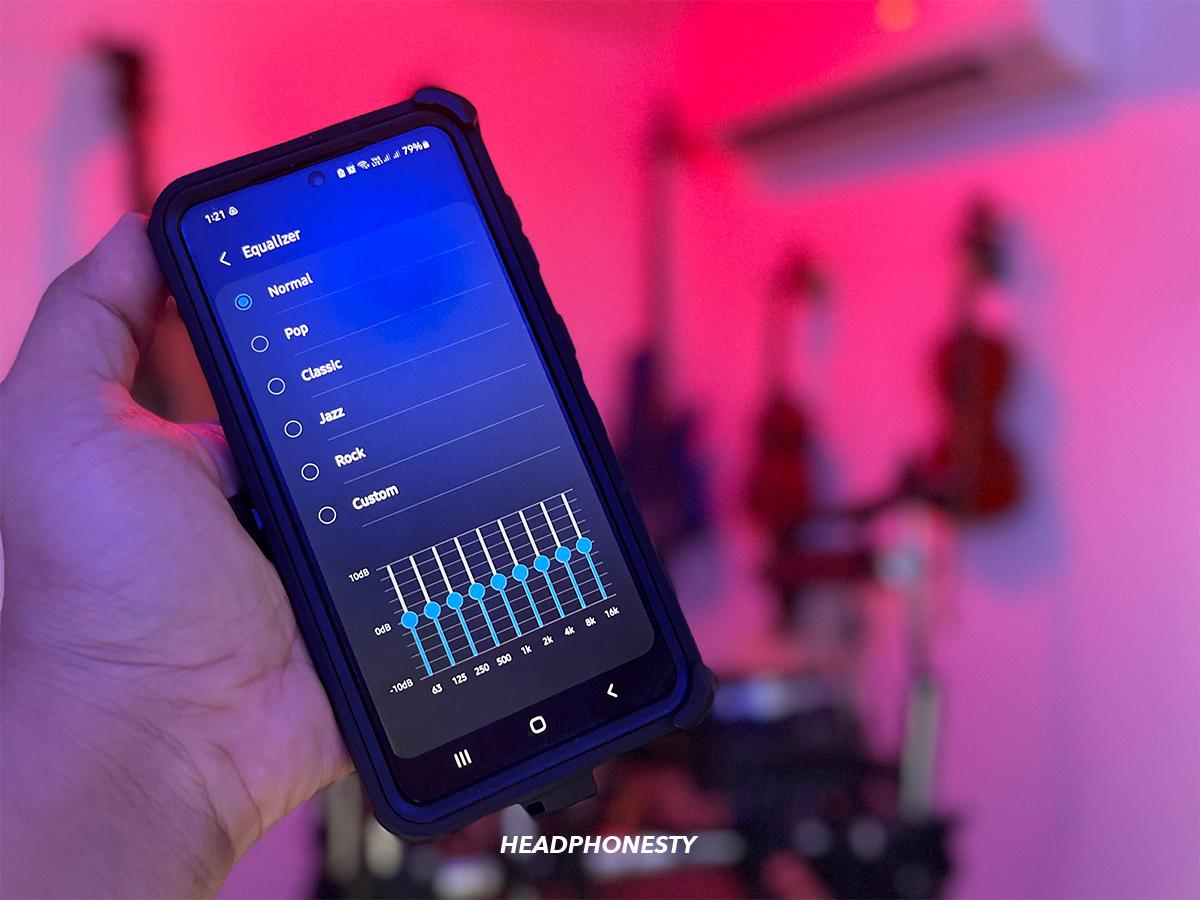
Spotify is far from being ‘ one of the best streaming services’. The only thing a pair of higher fidelity headphones would achieve would be to made the flaws of the Spotify (or other streaming service) music more obvious. But even mediocre headphones can easily demonstrate that.
Go suck a Walnut, Geoff.
😉
So what, if you don’t like then don’t use it.
Geoff, the family and i are sick of your shit.
He’s the best step bro I ever had
Sad that you are so enthusiastic to encourage ignorance.
Geoff, I wish you wasn’t so enthusiastic about wearing your headphones (noise cancelling ON I may add) when we spend time together 🙁 You even had headphones on when you proposed to me; on one knee, with a ring , as Geoff Wood say : “as ugly as 24kbit/s Spotify”. You didn’t even hear me say YES !
Geoff, it sucks to know that you’ve become a person like this. I had already warned you in middle school to stop wearing your headphones all the time otherwise you’d hurt your loved ones and see what’s happening… I can’t believe you’ve changed so much.
Woof Woof Woof
Woof Woof Woof Woof Woof Woof Woof Woof Woof Woof Woof Woof Woof Woof Woof Woof Woof Woof Woof Woof Woof Woof Woof Woof Woof Woof Woof Woof Woof Woof Woof Woof Woof Woof Woof Woof
Woof Woof Woof
Woof
The dog’s right Geoff – I’m disappointed in you.
Geoff, I thought you were a better person than this 🙁
Miau Miau Miau Miau Miau Miau Miau Miau Miau Miau Miau Miau Miauuuuuu Miiiiiiiiiiiiauuuuuuuuu Miau Miau Miaaaaaaaaaaaau Miiiiaaauuu Miauuuuuuu MiaaAAAAAAAAAA
MOOooo MOOOOOO MOOo MOOO MOOOO MOOOOO MOOOOOOOO MOO MOOoo moooooooooooooo MOOOOOOOOOOOOOOOOOOOOOOO
why am I so small 🙁
The Spotify equalizer giving the worst sound experience. My portable speaker sounds like a tin can no matter what. I downloaded a third party bass booster app and wow! my speaker comes to life.
huh can you state the 3rd party bass booster
We need to talk about your bill, Geoff.
My spotify doesn’t have an equalizer 🤷♀️
this probably change according to your device model, ios/ android etc. if you have android like me, we can not set on spotify, but we can do on our device equalizer setting
I am sorry to inform you via this app but I don’t think you have the qualities for the job anymore. Geoff, you are fired.
杰夫,请摘下耳机,伙计。别再听 24 KB 的音乐了。
My dad can’t read noodles